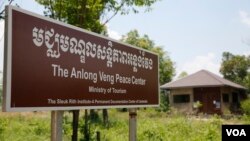The head of the Documentation Center of Cambodia has called on the Khmer Rouge tribunal to include one of the regime’s most iconic sites in its list of reparations.
Youk Chhang, director of DC-Cam, said in a letter to Marie Guiraud, a lawyer at the tribunal, that the Anlong Veng Peace Center Project should be supported with reparations money.
The project, located atop Dangrek Mountain, where one of the regime’s most notorious leaders, Ta Mok, was based, was apparently excluded from the list of funded projects as it was “a location for the perpetrators” and no civil parties lived there, Chhang told VOA Khmer.
DC-Cam has supported the Peace Center since 2015 with the aim of bridging the divide between former regime members and Cambodia’s youth through educational programs.
“I understand that you have made the decision not to include the Anlong Veng Peace Center in the list of proposed reparation projects in Case 002/02. As I stated in our email correspondence on 21 April 2017, I was not aware until now as to the exact reasons,” Chhang said in the letter.
“Nothing can compensate what we have lost and therefore, all initiatives must be considered and supported at all cost,” he told VOA Khmer in an interview.
He also criticized the court for not consulting the 17 civil parties from the province before making the decision.
“The Extraordinary Chambers in the Courts of Cambodia (ECCC)’s legacy must not only be justice and accountability, but also reconciliation. Reparation projects offer a way to extend the impact of the Court in innovative ways that not only benefit Civil Parties and Khmer Rouge Victims, but also bringing the society together,” he said, using the formal name for the Khmer Rouge tribunal.
Guiraud did not immediately respond to questions, however, in a letter responding to Chhang on April 25, the court’s victim support section said “the reasons for this decision were no civil parties reside in Anlong Veng, and there was not a sufficient link between the project and the scope of Case 002/02. It was also mentioned that another Peace Center had been already been proposed by another NGO.”
However, it added that the decision would be reconsidered.
Morn Mao, 64, a civil party who’s uncle was killed by the regime, said he supported the funding of the Peace Center.
“It is a site of former Khmer Rouge, but I never thought of taking revenge. I think the center can tell the next generation about the regime led by Khmer Rouge,” he told VOA Khmer.
Hov Teng, 62, another civil party, who lost 23 relatives under the regime, said he wanted to see more sites developed similar to the Peace Center across the country.
“I want the Khmer Rouge tribunal to acknowledge the center. Having the center is a good thing,” he said.
Hong Kimsuon, a lawyer for the civil parties, said the maintenance of such sites “can remind the people with bloody hands about the suffering of Cambodians during the Khmer Rouge, and not to have a cruel heart.”









